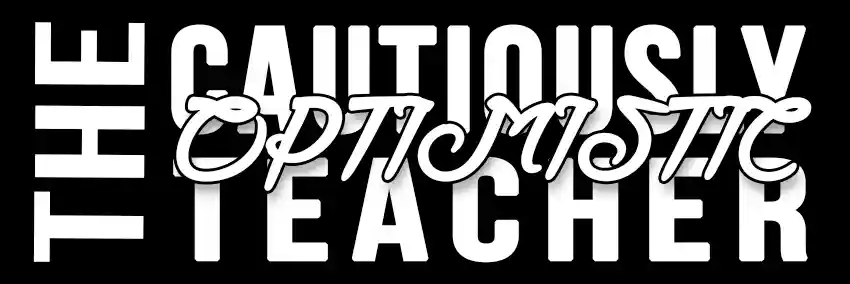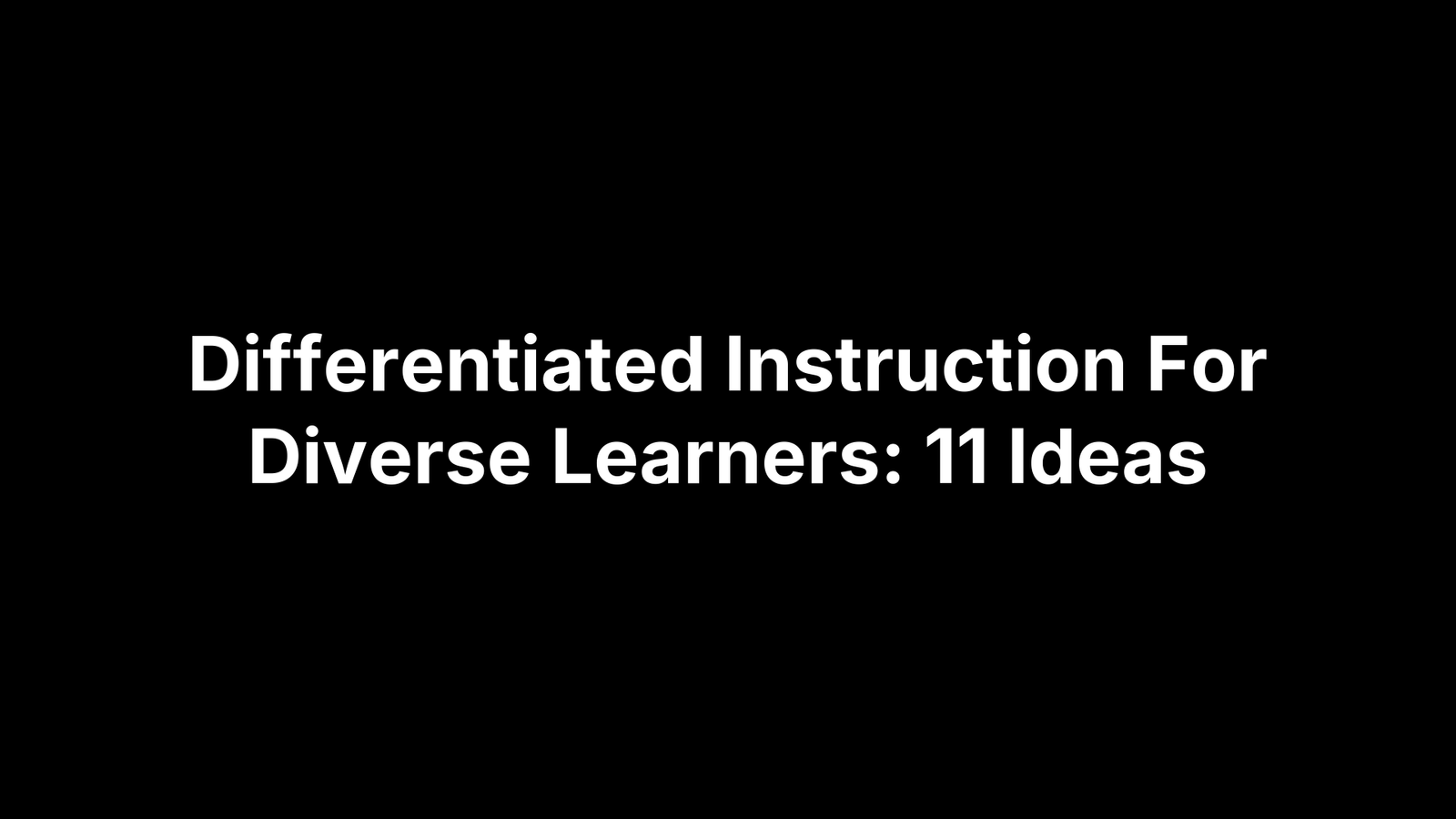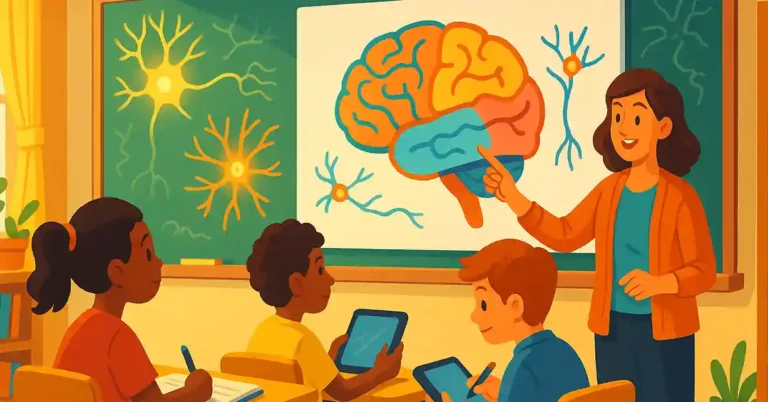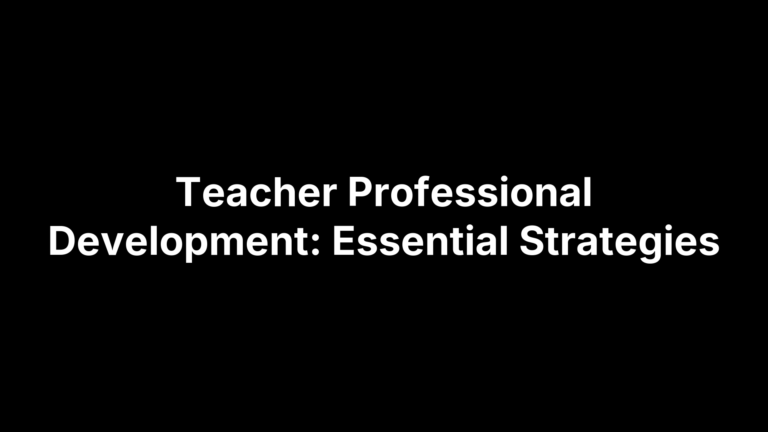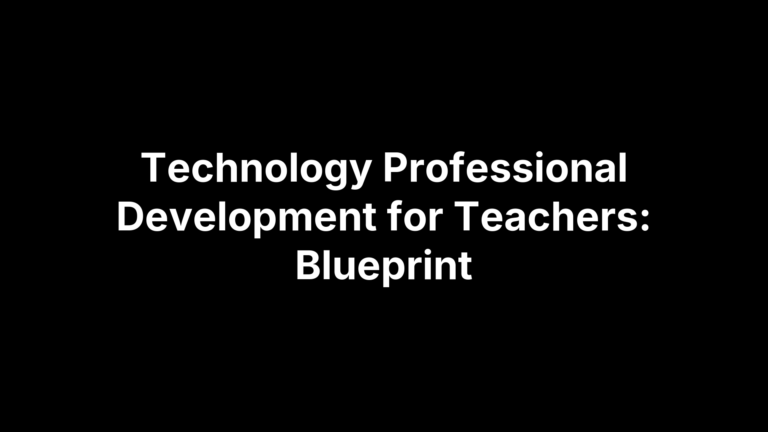Differentiated Instruction For Diverse Learners: 11 Ideas
You have 28 students sitting in front of you. Five are reading three grades below level. Three are gifted and finish everything in half the time. Seven have IEPs. Four are English language learners. Two have ADHD. And you’re supposed to reach every single one of them in the next 42 minutes. The pressure to differentiate instruction for every learner feels impossible when you’re already drowning in grading, meetings, and lesson plans.
Here’s the truth: differentiation doesn’t mean creating 28 individual lesson plans. It means making smart, strategic choices that let you teach different students at different levels without burning out. This article breaks down 11 practical differentiation strategies you can actually use tomorrow. You’ll get specific examples of what each idea looks like in real classrooms, understand exactly how it supports diverse learners, and walk away with concrete steps to implement it right away. These aren’t theoretical frameworks or abstract philosophies. They’re tested approaches that work for busy teachers who need results without sacrificing their evenings and weekends.
1. Use AI tools from The Cautiously Optimistic Teacher
You can implement differentiated instruction for diverse learners without spending hours creating multiple versions of every assignment. The AI-powered tools at The Cautiously Optimistic Teacher handle the heavy lifting of differentiation while you focus on actual teaching. These tools transform a single lesson concept into multiple learning pathways that meet students exactly where they are.
What this idea looks like
The Differentiated Instruction Helper takes your standard lesson and creates tiered versions automatically. You input your learning objective and grade level, then receive scaffolded materials for below-grade, on-grade, and above-grade learners in minutes. The Worksheet Maker generates customized practice activities from keywords you provide, adjusting complexity based on student needs. Meanwhile, the Question Generator transforms your text into critical thinking questions at various depth levels, giving advanced students extension work while struggling students tackle foundational concepts. You don’t create three separate lessons manually. You create one core concept and let the tools adapt it for different readiness levels.
The best differentiation tools multiply your impact without multiplying your workload.
How it supports diverse learners
These AI tools give every student access to grade-level content while providing the exact support or challenge each learner needs. Struggling readers get the same concepts as their peers but with simplified vocabulary and sentence structure. Advanced students receive extensions that push their thinking deeper instead of just more work. English language learners benefit from multiple entry points to the same material, and students with processing difficulties get information broken into manageable chunks. The tools eliminate the false choice between meeting individual needs and covering required curriculum. Your gifted students stay engaged while your intervention students build confidence, all working toward the same learning target.
How to get started tomorrow
Pick one upcoming lesson where you know your students will struggle with the range of abilities in your room. Visit The Cautiously Optimistic Teacher and try the Differentiated Instruction Helper first. Input your learning objective and let it generate three versions of your instruction. Review the outputs and adjust any sections that don’t match your students or teaching style. Save these versions in your lesson plan folder with clear labels for each group. Tomorrow, assign students to the appropriate version based on their current performance data, not fixed ability labels. Watch how much smoother your lesson flows when students work at their actual level instead of everyone receiving identical instruction.
2. Start with clear goals and must know learning
You cannot differentiate effectively until you identify exactly what students must know versus what would be nice to know. Teachers who skip this step end up differentiating everything, which creates impossible workload and dilutes focus. The foundation of differentiated instruction for diverse learners starts with defining non-negotiable learning targets that every student will reach, regardless of their path to get there. This clarity lets you spend differentiation energy where it matters most.
What this idea looks like
You begin each unit by writing 2-3 essential learning goals that describe what mastery looks like in observable, measurable terms. These goals appear at the top of your lesson plans, on student handouts, and in your classroom. During a persuasive writing unit, your essential goal might read: "Students will write a claim supported by three pieces of evidence and explain how each piece connects to their argument." Everything else becomes flexible or optional. The specific topic students write about? Flexible. The length of their essay? Adjustable. Whether they type or handwrite? Their choice. Your core expectation stays constant while the pathway to reach it varies by student need.
Clear learning targets give students a destination without forcing everyone down the same road.
How it supports diverse learners
This approach lets struggling learners focus their limited energy on what truly matters instead of getting lost in peripheral details. Advanced students recognize they must demonstrate the same core competencies as everyone else, eliminating the perception that differentiation means watered-down work. English language learners benefit from understanding exactly which vocabulary and concepts they must master versus which terms provide helpful context. Students with executive functioning challenges get laser-focused goals instead of vague assignments that lead to paralysis. Parents see transparent expectations and understand how modified assignments still address grade-level standards.
How to get started tomorrow
Pull up your next unit plan and highlight every standard you’re supposed to cover. Now cross out anything that isn’t absolutely essential for students to function at the next grade level or in real-world applications. What remains becomes your must-know list. Write these 2-3 goals in student-friendly language and post them where you’ll see them during planning. When you create assignments or assessments, ask yourself: "Does this task require students to demonstrate my core goals, or am I testing optional knowledge?" Adjust your materials to align with your priorities. Share these streamlined goals with students at the start of your next lesson.
3. Use quick pre assessments to know students
You waste precious instructional time when you guess at student readiness instead of measuring it accurately. Quick pre-assessments reveal exactly what students already know before you plan differentiated lessons, eliminating the common mistake of teaching content students mastered last year or skipping foundational skills they never learned. These low-stakes checks take 5-10 minutes but save hours of reteaching and frustration. Smart teachers use pre-assessment data to group students, adjust materials, and focus intervention efforts where they’ll make the biggest impact.
What this idea looks like
Quick pre-assessments look nothing like traditional tests. You might use a 3-question exit ticket covering next week’s concepts, a one-minute whiteboard activity where students solve a problem and hold up their answers, or a digital poll asking students to rate their confidence with upcoming skills. During a unit on fractions, you give students four problems that range from identifying fractions to adding them, then scan responses to see who needs remediation versus who’s ready for multiplication. These assessments happen before instruction begins, not after, and they never go in the gradebook. Students view them as helpful information rather than high-pressure evaluation.
Pre-assessment transforms guesswork into precision, letting you teach students exactly what they need.
How it supports diverse learners
Pre-assessments prevent struggling students from sitting through instruction on concepts they haven’t mastered yet while stopping advanced learners from enduring lessons on skills they conquered months ago. Students with learning disabilities benefit when you identify specific gaps in their understanding rather than assuming they need help with everything. English language learners get appropriately placed based on content knowledge rather than language proficiency alone, ensuring you don’t confuse limited English with limited understanding. Every student receives instruction matched to their current level instead of the fictional average student who doesn’t exist in your classroom.
How to get started tomorrow
Create a simple pre-assessment for your next major lesson by selecting 3-5 problems or questions that represent the span of skills students will learn. Include at least one foundational question, two grade-level questions, and one extension question so you can identify the full range of readiness. Administer this assessment at the start of class using whatever format works fastest (paper, digital, verbal response). While students work independently, quickly sort responses into three piles: needs support, ready for grade-level work, and ready for challenge. Use these groups to plan your differentiated instruction for diverse learners tomorrow, adjusting your lesson materials based on actual student data rather than assumptions.
4. Group flexibly for small group instruction
You achieve true differentiated instruction for diverse learners when you stop assigning students to permanent groups based on perceived ability. Flexible grouping means you reorganize students frequently based on specific skills, interests, or learning needs for each lesson or unit. Students work with different peers across multiple grouping configurations instead of sitting with the same "high" or "low" group all year. This eliminates tracking while ensuring every student gets targeted instruction matched to their current needs.
What this idea looks like
Flexible grouping changes daily or weekly depending on what students need for specific learning targets. On Monday, you group students by reading level for a comprehension strategy lesson. Tuesday, you regroup them by interest for research topics. Wednesday brings mixed-ability pairs for peer teaching. Thursday, students choose their own groups for a collaborative project. Friday, you pull small groups based on quiz results from earlier in the week. Your lowest readers might work with advanced students during collaborative tasks but receive targeted phonics instruction in homogeneous groups. No student sits in the same spot with the same people doing the same level work every single day.
Flexible grouping gives students access to different peers and instruction types without the stigma of permanent tracking.
How it supports diverse learners
This approach prevents struggling learners from internalizing fixed identities as "slow kids" who always sit at the red table. Advanced students develop collaboration skills and empathy when working with peers at various levels instead of only competing with other high achievers. Students with social challenges benefit from exposure to different classmates and group dynamics rather than being stuck with incompatible personalities. English language learners gain language models from fluent speakers in mixed groups while receiving targeted support in homogeneous settings. Every configuration serves a specific instructional purpose rather than reinforcing rigid hierarchies.
How to get started tomorrow
Map out next week’s lessons and identify which grouping strategy serves each learning target best. Write specific grouping plans in your lesson notes: "Monday = skill-based groups for fraction intervention, Tuesday = interest groups for historical research, Wednesday = random pairs for vocabulary practice." Create a simple seating chart template you can modify quickly rather than permanent arrangements. Before your first lesson, explain to students that they’ll work with different people for different purposes, emphasizing that flexible groups help everyone learn better. Implement your first grouping change tomorrow and watch how students respond when they realize groups aren’t fixed labels but temporary learning tools.
5. Vary content with levels and scaffolds
You deliver differentiated instruction for diverse learners most effectively when you adjust the complexity of materials while keeping the learning target constant for everyone. Varying content means you provide the same essential information at different reading levels, with strategic scaffolds that help struggling students access grade-level concepts without dumbing down the curriculum. Advanced students receive enriched versions with additional complexity rather than just more of the same work. This approach maintains high expectations for all learners while acknowledging they need different entry points to reach the same destination.
What this idea looks like
Content differentiation shows up in your classroom as tiered texts covering identical topics at three reading levels, graphic organizers that break complex information into manageable chunks for students who need structure, and sentence frames that help English language learners express sophisticated ideas. During a civil rights unit, your on-level students read original historical documents while struggling readers access the same information through adapted texts with simplified syntax and vocabulary definitions. Advanced students analyze primary sources with contradictory viewpoints that require synthesis skills. Each version teaches the same historical content and targets the same learning standards, but the reading demand matches student ability.
Strategic scaffolding gives every student access to grade-level content without lowering your expectations.
How it supports diverse learners
This strategy ensures struggling readers don’t miss critical content simply because they can’t decode complex text. Students with learning disabilities benefit from scaffolds like highlighted key terms, chunked paragraphs, and visual supports that reduce cognitive load. Advanced learners stay engaged with enriched materials that extend their thinking beyond basic comprehension. English language learners access grade-level concepts through modified language rather than being relegated to below-grade content. Every student works toward the same learning objectives with materials matched to their current reading and processing abilities.
How to get started tomorrow
Identify one key text in your next lesson that typically frustrates some students while boring others. Find or create two additional versions of this text using online readability tools or AI assistance: one version at two grades below your target level and one with additional complexity for advanced readers. Add scaffolds to the below-grade version such as bolded vocabulary, margin definitions, or guiding questions. Enhance the advanced version with analytical prompts or supplementary information. Assign versions based on your pre-assessment data, ensuring students receive materials they can successfully navigate while still reaching your core learning target.
6. Differentiate process with choices and support
You maximize differentiated instruction for diverse learners when you vary how students learn rather than just what they learn. Process differentiation means you offer multiple pathways for students to engage with content, practice skills, and make sense of concepts. Students choose from structured options that match their learning preferences while you provide targeted support based on readiness levels. This transforms passive instruction into active engagement where students take ownership of their learning journey without sacrificing academic rigor.
What this idea looks like
Process differentiation appears in your classroom as learning menus where students select from activities like creating visual diagrams, discussing concepts with partners, or writing analytical responses. During a vocabulary unit, some students use flashcard practice while others create concept maps, and still others teach words to peers through examples. You provide tiered support by circulating to different groups: offering sentence starters to struggling writers, posing extension questions to advanced thinkers, and checking comprehension with students who need monitoring. Your instruction stations might include a teacher-led group for direct instruction, an independent practice area with optional resources, and a collaborative space for peer learning.
Strategic choice in learning processes keeps students engaged while ensuring everyone reaches the same rigorous standards.
How it supports diverse learners
This approach helps kinesthetic learners who need movement rather than sitting through lectures, visual learners who benefit from graphic representations of concepts, and auditory learners who process through discussion. Students with attention difficulties stay focused when they control their learning pace and method. Advanced students pursue deeper inquiry through self-selected challenges while struggling learners access teacher guidance without feeling singled out. English language learners gain flexible processing time through options like partner discussion before written work. Everyone demonstrates understanding through their strongest learning channel instead of forcing all students through identical processes.
How to get started tomorrow
Design a choice board for your next major concept with three learning process options that appeal to different strengths: one visual, one verbal, and one hands-on. Write clear instructions for each option and establish non-negotiable criteria that every choice must meet. Plan where you’ll position yourself to provide targeted support during work time, prioritizing students who need the most guidance. Introduce choices to students by explaining that different processes work for different people, and they should select the option that helps them learn best. Circulate actively during the lesson to offer strategic scaffolds matched to student needs while they work through their chosen process.
7. Offer options for products and final tasks
You complete the differentiation cycle when you let students demonstrate learning through different final products instead of forcing everyone to complete identical assignments. Product differentiation means you evaluate students on mastery of learning targets rather than submission of a single artifact type. Students choose how to showcase their understanding from structured options while you assess them against the same rigorous standards. This approach reveals true comprehension while honoring different student strengths and processing styles.
What this idea looks like
Product differentiation shows up as choice boards where students select from options like written essays, visual presentations, oral explanations, or creative projects to demonstrate the same learning standards. During a novel study unit, you require every student to analyze character development and theme, but they choose whether to submit a traditional literary analysis, create an annotated character timeline, record a podcast discussion, or design a visual storyboard. Each option requires students to cite textual evidence, explain their thinking, and demonstrate the same critical analysis skills. You provide a rubric that evaluates these core competencies regardless of format, ensuring students can’t choose an easy option that avoids rigorous thinking.
How it supports diverse learners
This strategy helps struggling writers who understand concepts deeply but can’t express ideas through formal essays. Students with learning disabilities demonstrate knowledge through their strongest output channel rather than being penalized for weak areas unrelated to learning targets. Advanced learners pursue sophisticated products that challenge their abilities instead of completing busywork versions of tasks they’ve already mastered. English language learners showcase comprehension through visual or oral formats while continuing to develop writing skills without being limited by current language proficiency.
Strategic product choice reveals what students truly know instead of measuring their ability to complete one specific task type.
How to get started tomorrow
Create a product menu for your next summative assessment with three options that require identical core skills but appeal to different strengths: one written, one visual, one presentation-based. Design a single rubric that evaluates learning target mastery regardless of product type, ensuring all options demand equal rigor. Introduce choices by explaining that different products help different people show their best thinking, but every option must prove the same skills. Review student selections to ensure distribution across options and redirect students choosing based on perceived ease rather than genuine learning preference.
8. Teach with multiple modalities and UDL ideas
You reach more diverse learners when you design lessons that engage multiple senses and learning pathways from the start rather than retrofitting accommodations later. Universal Design for Learning (UDL) principles guide you to provide varied ways for students to access information, process concepts, and demonstrate understanding. This proactive approach benefits every student while specifically supporting learners with disabilities, different learning preferences, and varied processing speeds. Teaching through multiple modalities transforms your classroom into an accessible learning environment where differentiation becomes built-in rather than added on.
What this idea looks like
Multiple modality instruction appears in your classroom as lessons that simultaneously engage visual, auditory, and kinesthetic channels. During a science unit on ecosystems, you show labeled diagrams while verbally explaining relationships, then have students physically arrange organism cards to model food webs. You provide written instructions alongside oral directions and pair abstract concepts with concrete examples students can manipulate. Your vocabulary instruction includes written definitions, images representing each word, example sentences students read aloud, and physical gestures or movements associated with terms. Technology supports this approach through video demonstrations, interactive simulations, and audio options for text-based materials.
How it supports diverse learners
This strategy ensures visual learners receive diagrams and graphic organizers while auditory learners benefit from discussions and verbal explanations. Students with reading disabilities access content through audio and video formats instead of struggling with text alone. Kinesthetic learners stay engaged through hands-on activities and movement rather than passive listening. English language learners gain contextual support through images and demonstrations that clarify vocabulary beyond definitions. Students with attention difficulties maintain focus when instruction changes modality and format every 10-15 minutes rather than demanding sustained attention to a single input type.
UDL transforms accessibility from an accommodation into a teaching foundation that elevates learning for everyone.
How to get started tomorrow
Review your next lesson and identify which single modality you typically rely on most heavily (usually lecture or text). Add two additional modalities by incorporating a visual element like an infographic or diagram and a kinesthetic component such as a sorting activity or physical demonstration. Create a lesson checklist that reminds you to include something students see, something they hear, and something they do in every major lesson. Gather basic manipulatives like index cards, sticky notes, or small objects students can use during hands-on processing of abstract concepts. Explain to students that you’ll present information through different formats to help everyone learn effectively.
9. Make learning culturally responsive and safe
You cannot achieve differentiated instruction for diverse learners without creating a classroom where every student sees themselves reflected in the curriculum and feels safe taking academic risks. Culturally responsive teaching means you deliberately include diverse perspectives, validate students’ backgrounds, and build instruction around their lived experiences rather than treating white, middle-class culture as the default. This approach transforms your classroom from a space where some students feel like outsiders into a community where everyone belongs. Students learn better when they trust you understand and value who they are.
What this idea looks like
Culturally responsive classrooms feature texts and examples that represent diverse races, cultures, languages, family structures, and socioeconomic backgrounds rather than tokenizing diversity during heritage months. You incorporate student names and experiences into math word problems, connect historical events to students’ cultural backgrounds, and invite families to share expertise related to unit topics. Your classroom library includes protagonists of color, LGBTQ+ characters, and stories set in communities your students recognize. Wall displays celebrate multiple perspectives on historical events rather than presenting single narratives. You learn correct pronunciation of every student’s name and use preferred pronouns without making students repeatedly correct you.
Culturally responsive teaching recognizes that curriculum choices either validate or erase student identities.
How it supports diverse learners
This strategy helps students of color see their experiences valued in academic spaces instead of treated as supplementary. Students from low-income backgrounds engage more deeply when curriculum reflects their realities rather than assuming middle-class experiences as universal. English language learners benefit when you position bilingualism as strength rather than deficit. LGBTQ+ students feel safer participating when you use inclusive language and examples. Students with trauma histories learn better in psychologically safe environments where teachers demonstrate cultural awareness and avoid microaggressions that trigger defensive responses.
How to get started tomorrow
Audit your next unit plan for cultural representation in texts, examples, and historical figures, then add at least three resources that reflect your students’ diverse backgrounds. Replace generic examples in practice problems with student names and contexts from your actual classroom community. Learn how to pronounce every student’s name correctly by asking them to teach you and practicing until you get it right. Survey students about their cultural traditions, family structures, and interests, then incorporate this information into upcoming lessons. Establish classroom norms that explicitly value diverse perspectives and create consequences for disrespectful comments rather than letting microaggressions slide.
10. Build student ownership with goals and reflection
You transform differentiated instruction for diverse learners from something you do to students into something they actively control when you teach them to set learning goals and reflect on their progress. Student ownership means learners understand their current abilities, identify specific skills to improve, and monitor their own growth rather than passively receiving instruction you differentiate for them. This approach develops metacognitive skills that help students become self-directed learners who can advocate for the support they need. When students take responsibility for their learning journey, differentiation becomes a partnership instead of a teacher-driven accommodation.
What this idea looks like
Student ownership shows up in your classroom through goal-setting conferences where students review their performance data and write specific, measurable targets for improvement. You provide a simple template that asks students to identify one skill they’ve mastered, one skill they’re developing, and one skill they want to strengthen. Students track progress in learning journals where they reflect weekly on what strategies helped them learn, what challenges they faced, and what they’ll try differently next time. During lessons, you pause for quick reflection prompts where students assess their current understanding on a scale of one to five, then choose whether they need more practice, peer help, or independent challenge work. These practices make learning visible to students instead of keeping it mysterious.
Teaching students to monitor their own progress creates independent learners who understand how they learn best.
How it supports diverse learners
This strategy helps struggling students recognize small wins and specific growth rather than feeling globally behind their peers. Advanced learners develop realistic self-assessment skills instead of coasting on natural ability without building work habits. Students with learning disabilities gain language to articulate which accommodations help them succeed rather than accepting whatever adults decide. English language learners track content understanding separately from language development, seeing progress in multiple areas. Every student builds the self-awareness and advocacy skills they’ll need beyond your classroom when teachers won’t automatically differentiate for them.
How to get started tomorrow
Create a simple goal-setting template with three sections: "I can already," "I’m working on," and "My next goal is." Schedule five minutes at the end of your next lesson for students to complete this reflection based on today’s work. Collect and review responses to understand how accurately students assess their abilities compared to your observations. Use this information to teach students calibration skills by sharing examples of well-written goals and helping them distinguish between vague wishes and specific targets. Implement weekly check-ins where students update their goals and note what helped them make progress, gradually building their capacity to direct their own differentiated learning.
11. Create a system to keep differentiation doable
You abandon differentiated instruction for diverse learners when it becomes unsustainable, which happens when you lack organizational systems to manage multiple versions of lessons, materials, and assessments. Creating a system means you establish routines, templates, and organizational structures that make differentiation efficient rather than overwhelming. This transforms differentiation from an exhausting daily scramble into a manageable workflow you can maintain consistently throughout the year. Smart systems reduce decision fatigue and free your mental energy for actual teaching instead of constant logistics.
What this idea looks like
Systematic differentiation appears in your classroom as color-coded folders for each readiness level, digital file systems with clear naming conventions, and reusable lesson templates that include differentiation planning prompts. You maintain a student profile sheet with current reading levels, learning preferences, and accommodation needs in one accessible document instead of hunting through multiple files. Your weekly planning includes a standing block of time dedicated to adjusting materials rather than squeezing it in randomly. Template documents contain scaffolds, sentence frames, and graphic organizers you can quickly customize for specific content. You create anchor charts that explain differentiation routines to students so they know how to access appropriate materials without constant teacher direction.
Sustainable differentiation requires systems that reduce your workload while increasing your instructional precision.
How it supports diverse learners
This approach ensures consistent differentiation instead of sporadic efforts that happen only when you have extra time and energy. Students receive appropriate support and challenge every lesson rather than hit-or-miss accommodations based on teacher bandwidth. Struggling learners know exactly where to find scaffolded materials without feeling singled out each time they need help. Advanced students access extension work through established routines rather than waiting for you to notice they finished early. Systems eliminate the chaos that disproportionately harms students with executive functioning challenges who need predictable structures to succeed.
How to get started tomorrow
Dedicate 30 minutes this week to creating three organizational structures: a digital folder system labeled by unit and readiness level, a student data tracking sheet with current performance information, and one reusable lesson template with built-in differentiation prompts. Block recurring planning time on your calendar specifically for adapting materials, treating it as non-negotiable as other meetings. Choose your most frequent differentiation strategy from this article and create a template or routine that makes it repeatable without starting from scratch each time. Teach students the system for accessing different materials tomorrow by explaining your color-coding or digital organization method so they can work independently.
Final thoughts
Differentiated instruction for diverse learners stops being overwhelming when you build it into your regular teaching routine instead of treating it as extra work. You don’t need to differentiate everything or create completely individualized plans for every student. Start with one or two strategies from this list that address your most pressing classroom challenges, then add more approaches as these become automatic. The teachers who sustain differentiation long-term focus on systems and reusable structures rather than constantly reinventing materials from scratch.
Your students need you to take action on what you learned here instead of letting perfect become the enemy of good enough. Pick the single strategy that will make the biggest difference for your most struggling or most bored students, then implement it this week. Small changes compound over time when you apply them consistently. Visit The Cautiously Optimistic Teacher for more practical teaching resources including AI-powered tools that make differentiation faster and more effective without sacrificing your evenings.
